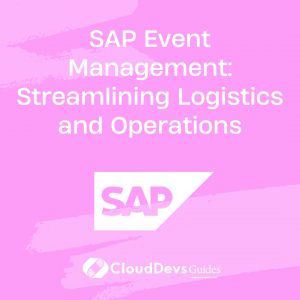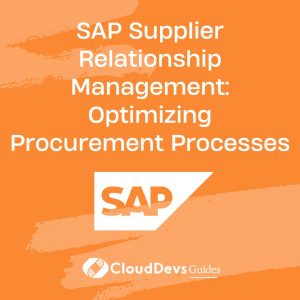SAP Event Management: Streamlining Logistics and Operations
In today’s fast-paced global business landscape, efficient logistics and operations management are critical for maintaining a competitive edge. The ability to monitor, track, and respond to events in real-time can make all the difference in optimizing supply chains and delivering exceptional customer experiences. That’s where SAP Event Management comes into play.

1. Introduction to SAP Event Management
SAP Event Management (SAP EM) is a powerful solution offered by SAP that allows organizations to gain end-to-end visibility into their supply chains and operational processes. It enables businesses to track events, monitor performance, and proactively respond to disruptions, ensuring smoother logistics and operations.
2. Why is SAP Event Management Important?
Logistics and operations involve a complex web of activities, from procurement and manufacturing to warehousing and distribution. Any disruption or delay in these processes can lead to increased costs, customer dissatisfaction, and missed opportunities. SAP Event Management addresses these challenges by:
- Enhancing Visibility: SAP EM provides real-time visibility into the entire supply chain, enabling organizations to monitor the movement of goods, track milestones, and identify potential issues early on.
- Proactive Problem Resolution: By detecting and alerting stakeholders about deviations from planned processes, SAP EM enables proactive problem resolution, reducing the impact of disruptions.
- Improved Customer Service: With accurate information at their fingertips, businesses can provide better customer service by offering precise delivery estimates and handling exceptions swiftly.
- Cost Reduction: By minimizing manual interventions, streamlining processes, and optimizing resource allocation, SAP EM helps reduce operational costs.
3. Key Features of SAP Event Management
SAP Event Management offers a range of features designed to streamline logistics and operations effectively. Let’s explore some of its key capabilities:
3.1. Event Monitoring
Event Monitoring is at the heart of SAP EM. It allows businesses to track events in real-time, providing a centralized view of the entire supply chain. This feature helps identify bottlenecks and delays promptly.
xml <event> <eventID>1001</eventID> <eventDescription>Goods Shipped</eventDescription> <eventTimestamp>2023-09-20T14:30:00</eventTimestamp> <eventLocation>Warehouse A</eventLocation> </event>
3.2. Alerting and Notification
SAP EM can trigger alerts and notifications based on predefined rules and thresholds. This ensures that stakeholders are informed immediately when an event deviates from the expected path.
java
if (event.getEventTimestamp().compareTo(expectedTime) > 0) {
sendNotification("Event delayed: " + event.getEventDescription());
}
3.3. Exception Management
Exception Management allows organizations to define and manage exceptions effectively. It helps in categorizing, prioritizing, and resolving issues as they occur.
sql SELECT * FROM exceptions WHERE status = 'Open' ORDER BY priority DESC;
3.4. Analytics and Reporting
SAP EM provides robust analytics and reporting tools, allowing businesses to gain insights into their operations. These insights can be used to optimize processes and make data-driven decisions.
sql SELECT AVG(deliveryTime) FROM deliveryPerformance WHERE deliveryDate BETWEEN '2023-01-01' AND '2023-09-20';
3.5. Integration Capabilities
SAP EM seamlessly integrates with other SAP solutions and third-party systems, ensuring a holistic view of your supply chain. This integration capability eliminates silos and improves data accuracy.
python from sap_em_integration import connect_to_sap_em connection = connect_to_sap_em()
4. Benefits of Implementing SAP Event Management
The implementation of SAP Event Management can bring several tangible benefits to your organization:
4.1. Enhanced Visibility
SAP EM provides real-time visibility into your supply chain, enabling you to track the movement of goods and monitor key milestones. This visibility helps you make informed decisions and respond quickly to changes.
4.2. Improved Efficiency
By automating event monitoring and exception handling, SAP EM reduces the need for manual interventions. This leads to increased operational efficiency and cost savings.
4.3. Better Customer Service
With accurate information about shipment status and delivery times, you can provide superior customer service. Customers appreciate transparency and reliability.
4.4. Reduced Costs
Streamlined processes and proactive issue resolution help in reducing operational costs. By preventing delays and optimizing resource allocation, SAP EM contributes to cost savings.
4.5. Compliance and Risk Management
SAP EM enables you to track compliance with regulatory requirements and manage risks effectively. It helps in identifying potential issues before they escalate into significant problems.
5. Use Cases of SAP Event Management
SAP Event Management can be applied across various industries and scenarios. Here are a few use cases that highlight its versatility:
5.1. Supply Chain Optimization
In the manufacturing industry, SAP EM can be used to optimize the supply chain by monitoring the movement of raw materials, work-in-progress, and finished goods. It ensures that production processes are efficient and any delays are addressed promptly.
5.2. Retail and E-commerce
In the retail sector, SAP EM helps in tracking inventory levels, managing the movement of goods between distribution centers and stores, and providing accurate delivery estimates to customers.
5.3. Healthcare
In healthcare, SAP EM can be utilized to monitor the transportation of critical medical supplies, ensuring they reach their destinations on time and in optimal condition.
5.4. Automotive
Automotive manufacturers can benefit from SAP EM by tracking the progress of vehicle production, managing the delivery of parts, and optimizing the distribution of finished vehicles to dealerships.
6. Getting Started with SAP Event Management
Implementing SAP Event Management involves several steps. Here’s a high-level overview of the process:
6.1. Requirements Analysis
Begin by identifying your organization’s specific logistics and operations requirements. Define the events and milestones you want to monitor.
6.2. System Configuration
Configure SAP EM to align with your business processes. This includes setting up event types, defining rules for event monitoring, and configuring alerting and notification settings.
6.3. Integration
Integrate SAP EM with your existing systems, such as ERP, warehouse management, and transportation management systems. This ensures seamless data flow and real-time updates.
6.4. Training
Train your team members on how to use SAP EM effectively. Ensure they understand the system’s capabilities and how to respond to alerts and exceptions.
6.5. Monitoring and Optimization
Once SAP EM is up and running, continuously monitor its performance and gather insights from analytics. Use this data to optimize your logistics and operations further.
7. SAP Event Management: A Competitive Advantage
In a rapidly evolving business environment, the ability to streamline logistics and operations is a competitive advantage. SAP Event Management empowers organizations with the visibility and control needed to thrive in this dynamic landscape. By proactively monitoring events, resolving issues, and optimizing processes, businesses can reduce costs, improve customer satisfaction, and stay ahead of the competition.
If you’re looking to gain a competitive edge and transform your logistics and operations, SAP Event Management is a solution worth considering. Its robust features, integration capabilities, and real-time monitoring make it a valuable asset for any organization seeking to optimize its supply chain and enhance customer experiences.
Conclusion
In conclusion, SAP Event Management is a game-changer for businesses aiming to streamline their logistics and operations. By providing real-time visibility, proactive issue resolution, and integration with existing systems, SAP EM empowers organizations to deliver superior customer service, reduce costs, and gain a competitive advantage in the market. Whether you operate in manufacturing, retail, healthcare, or automotive industries, SAP Event Management has the potential to revolutionize your supply chain and operational processes. Embrace the future of logistics and operations with SAP EM and stay ahead of the curve.
Table of Contents









